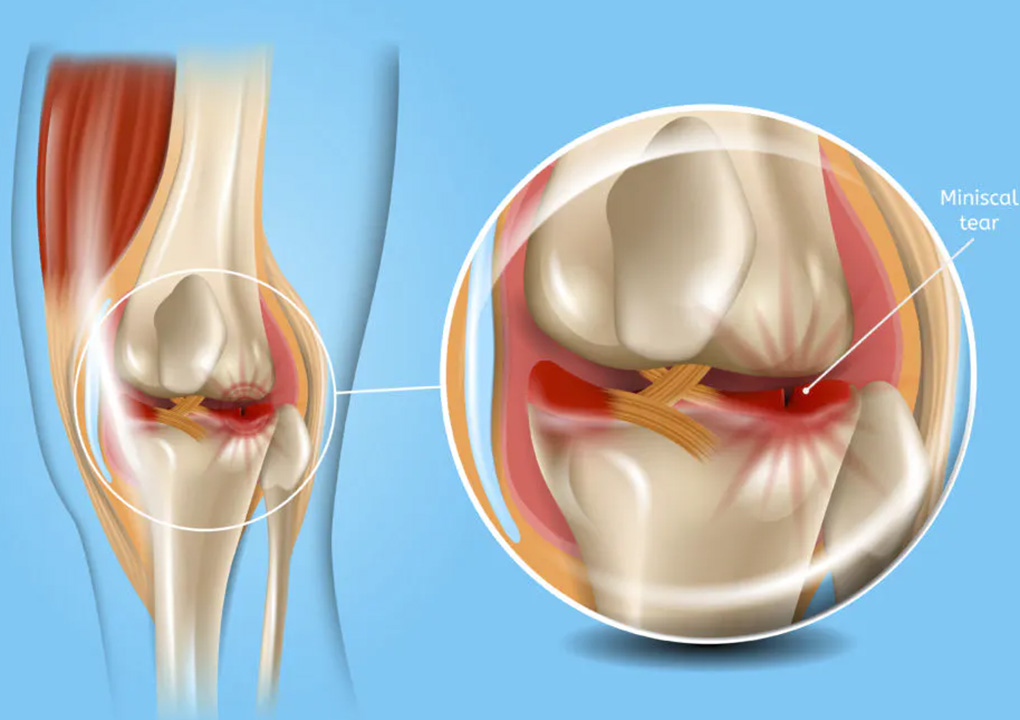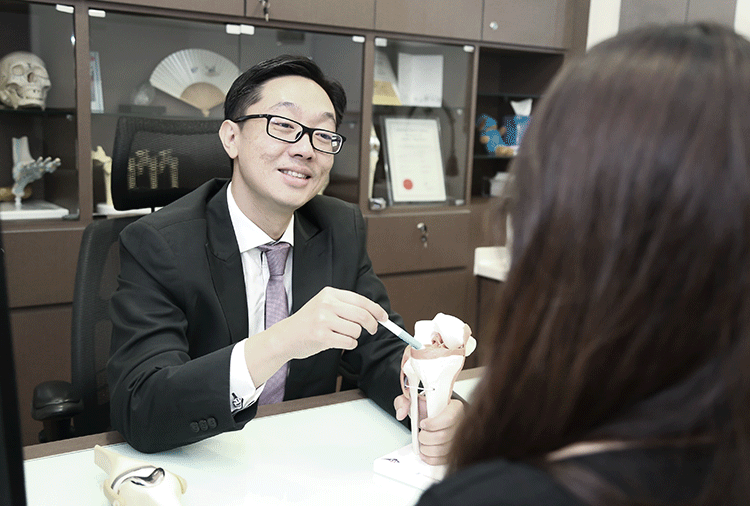A torn meniscus is a common knee injury involving damage to the rubbery cartilage discs (menisci) that cushion the knee joint. Treatment is crucial to alleviate pain, restore knee function, and prevent further damage to the knee.
What Is Torn Meniscus, and Why Is Treatment Important?
A torn meniscus refers to a tear or injury to one or both of the C-shaped cartilage discs (menisci) located between the thigh bone (femur) and shin bone (tibia) in the knee joint. Treatment is important to relieve pain, restore knee function, and prevent further damage to the knee joint. Without treatment, a torn meniscus can lead to persistent pain, swelling, instability, and an increased risk of developing osteoarthritis in the affected knee.
What Are the Causes and Risk Factors of Torn Meniscus?
Several factors can contribute to the development of a torn meniscus, including:
Trauma or Injury – Sudden twisting, pivoting, or forceful impact on the knee joint, such as those seen in sports injuries or accidents, can cause a tear in the meniscus.
Degenerative Changes – Wear and tear on the menisci over time, due to repetitive stress or age-related changes, can weaken the tissue and increase the risk of tearing.
Biomechanical Factors – Abnormalities in knee alignment, gait patterns, or muscle imbalances can increase the risk of meniscal tears.
Age – Meniscal tears are more common in older individuals, as the menisci become more brittle and prone to injury with age.
Sports Participation – Participation in sports or activities that involve sudden stops, twists, or changes in direction, such as soccer, basketball, or skiing, can increase the risk of meniscal tears.
What Are the Common Symptoms of Torn Meniscus?
The symptoms of a torn meniscus may vary depending on the severity and location of the tear, but commonly include:
Knee Pain – Pain in the knee joint, particularly along the joint line, which may worsen with certain movements or activities.
Swelling – Swelling or inflammation around the knee joint, often accompanied by warmth and redness.
Stiffness – Stiffness in the knee joint, especially after periods of inactivity or upon waking in the morning.
Catching or Locking Sensation – Sensation of the knee catching or locking, particularly during movements that involve bending or straightening the knee.
Popping or Clicking – Audible popping, clicking, or grinding sensations within the knee joint, particularly with movement.
Decreased Range of Motion – Decreased range of motion in the knee joint, making it difficult to fully bend or straighten the knee.
Instability – Feeling of knee instability or giving way, especially with weight-bearing activities or changes in direction.
How Is Torn Meniscus Diagnosed?
Diagnosing a torn meniscus typically involves a combination of medical history, physical examination, and imaging tests. Here’s how it’s usually diagnosed:
Medical History – Your doctor will ask about your symptoms, including any knee pain, swelling, stiffness, or limitations in movement. They may inquire about the onset of your symptoms, any activities or movements that exacerbate your symptoms, and any previous injuries or trauma to the knee.
Physical Examination – During the physical examination, your doctor will:
- Palpate the knee joint to check for tenderness, swelling, or deformity.
- Assess the range of motion of your knee and any associated pain or limitations.
- Perform specific manoeuvres to reproduce symptoms, such as the McMurray test, Apley’s compression test, or Thessaly test, which can help elicit pain, clicking, or locking sensations associated with a torn meniscus.
- Evaluate for joint stability, signs of joint effusion (fluid accumulation), and any signs of inflammation or instability.
Imaging Tests – MRI (Magnetic Resonance Imaging) and X-rays
What Are The Torn Meniscus Treatment Options?
Rest, Ice, Compression, Elevation (RICE)
Physical Therapy
Bracing
Minimally Invasive Procedures
Surgical Intervention
Meniscus Repair – In cases where the meniscus tear is located in the outer rim of the meniscus (the vascular zone) and is amenable to repair, surgical repair may be performed. Meniscus repair involves suturing the torn edges of the meniscus to promote healing and preserve as much healthy meniscal tissue as possible. Recovery from meniscus repair may be longer than partial meniscectomy but can help preserve long-term joint health.
Meniscus Transplantation – In cases where a large portion of the meniscus has been removed or if there is significant damage, meniscus may be considered. During this procedure, donor tissue is used to replace the damaged meniscus. Meniscus transplantation is typically reserved for younger, active individuals with persistent knee pain and dysfunction despite other treatments.
Activity Modification
Recovery And Prevention Strategies For Torn Meniscus
For Recovery:
- Initially, it’s crucial to rest the knee to allow the torn meniscus to heal. Avoid activities that exacerbate pain or cause further damage to the knee.
- Applying ice to the knee can help reduce pain and swelling. Use an ice pack or ice wrapped in a cloth and apply it to the affected area for 15-20 minutes several times a day.
- Using a compression bandage or sleeve around the knee can help reduce swelling and provide support during the healing process.
- Elevating the leg above the level of the heart can help reduce swelling. Prop up the leg with pillows when lying down or sitting.
- A physical therapist can design a customised rehabilitation program to strengthen the muscles around the knee, improve range of motion, and restore function. Exercises may include gentle stretching, strengthening exercises, and balance training.
- In some cases, particularly if the tear is severe or causing persistent symptoms, surgery may be necessary to repair or remove the torn portion of the meniscus.
- After recovery, gradually reintroduce activities and sports, starting with low-impact exercises and gradually increasing intensity and duration as tolerated.
For Prevention:
- Strengthening the muscles around the knee, including the quadriceps, hamstrings, and calves, can help provide better support and stability to the knee joint, reducing the risk of meniscus tears.
- Incorporate stretching exercises to maintain flexibility in the muscles and tendons surrounding the knee joint, which can help prevent strain and reduce the risk of injury.
Focus on using proper body mechanics and technique during sports and activities to avoid putting excessive stress on the knee joint. This includes learning proper landing and cutting techniques to reduce the risk of twisting injuries. - Always thoroughly warm up before engaging in physical activity to prepare the muscles and joints for movement. Likewise, incorporate a cool-down routine to help prevent stiffness and aid recovery.
- Incorporate various activities into your fitness routine to reduce repetitive stress on the knee joint. Cross-training can help maintain overall fitness while reducing the risk of overuse injuries.
- Listen to your body and avoid overtraining, which can increase the risk of injury. Allow for adequate rest and recovery between workouts or training sessions.
Choose appropriate footwear for your chosen activity, as proper footwear can help provide support and cushioning, reducing the impact on the knees and lower extremities.







